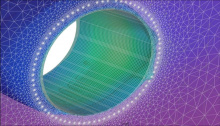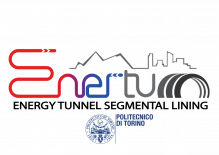Energy tunnels and geothermal applications

The Heat is a form of energy and geothermal energy is, literally, the heat contained within the Earth that generates geological phenomena on a planetary scale. 'Geothermal energy' is often used nowadays, however, to indicate that part of the Earth's heat that can, or could, be recovered and exploited by man. The heat captured from the soil is used for heating and cooling buildings and infrastructures. In fact, there are several technical means to tap this vast resource by extracting heat from the ground: a) horizontal coils, b) groundwater wells, c) borehole heat exchangers (BHE) and d) energy geostructures.
The energy geostructures are particular geotechnical structures conveniently instrumented for exchanging heat with the soil. The research activities in this field focus mainly on the understanding of the behavior of energy geostructures and on the optimization of their usage.
Thermoactive geostructures for near-surface geothermal energy
 This research field is devoted to investigate the possibility of implementing geothermal plants into concrete structures in contact with the ground, such as foundations, retaining walls, tunnel lining and diaphragms. This new technology couples the primary role of geostructures with the geothermal energy exploitation, resulting in a reduction of installation costs with respect to classical geothermal systems. Energy geostructures are low enthalpy systems which can be used for purpose of cooling and heating of buildings and infrastructures, as well as for road de-icing.
This research field is devoted to investigate the possibility of implementing geothermal plants into concrete structures in contact with the ground, such as foundations, retaining walls, tunnel lining and diaphragms. This new technology couples the primary role of geostructures with the geothermal energy exploitation, resulting in a reduction of installation costs with respect to classical geothermal systems. Energy geostructures are low enthalpy systems which can be used for purpose of cooling and heating of buildings and infrastructures, as well as for road de-icing.
 During winter, the ground becomes a source of heat for heating the building while during summer it becomes a sink for releasing the heat that comes from the building conditioning. This is possible thanks to the quite constant temperature of the ground all over the year and realized by simply embedding a system of pipes inside the concrete, with a heat carrier fluid circulating through them and exchanging heat with the soil, connected to a heat pump. The research activities in this field are mainly devoted to geothermal tunnels.
During winter, the ground becomes a source of heat for heating the building while during summer it becomes a sink for releasing the heat that comes from the building conditioning. This is possible thanks to the quite constant temperature of the ground all over the year and realized by simply embedding a system of pipes inside the concrete, with a heat carrier fluid circulating through them and exchanging heat with the soil, connected to a heat pump. The research activities in this field are mainly devoted to geothermal tunnels.
Enertun - Energy tunnel segmental lining
Studies in the area of energy geostructures allowed to develop Enertun, a novel tunnel precast segmental lining for tunnels constructed by TBM (Patent number 102016000020821). An experimental site in the tunnels of the Turin metro line 1 is under construction. Research team: Marco Barla (professor), Alice Di Donna (research assistant), Alessandra Insana (PhD student), Giorgio Giannì (scholar). More information on the Enertun Facebook page, on the Knowledge share official website or from the Enertun video.
GeothermSkin - Energy wall modular system
 This energy system allows for the realization of a geothermal installation by employing the earth-contact portions of buildings as exchanging surfaces.
This energy system allows for the realization of a geothermal installation by employing the earth-contact portions of buildings as exchanging surfaces.
The system is made up of modules that assemble an hydraulic circuit where heat exchange takes place and allows to equip all the available surfaces of the building. System installation is simple: modules are extenally applied to the walls as the final step of the construction process. In the case of existing buildings, once the wall is exposed thanks to excavation, the modules can be applied. GeothermSkin system is the result of long experience in innovation in the field of energy geostructures (Patent priority number 102019000024604).
Once the deployment is done, the walls are buried and the surface can be restored. The final result completely hides the interventions done.
Linking of modules with the building allows to collect in a single collector the heat carrier fluid and circulate it to the technical room where a water-to-water heat pump is installed.
More information on the Knowledgeshare platform, on the CO2 Circle Lab web site or from the Geothermskin video and the RockMech youtube channel.
Optimization of geothermal resources in urban areas

Whenever a geothermal installation is planned, the first question to be answered is about the exchangeable amount of energy. There are a lot of aspects influencing this quantity known as Geothermal potential. Among these factors, some are site-dependant, as groundwater fluxes presence and velocity and temperature. These factors might be evaluated with good reliability in rural areas and then manipulated to assess the site-specific geothermal potential. On the contrary, urban context are characterised by high variability of groundwater flow field due to the presence of underground structures and infrastructures (e.g.Urban Tunnels). Furthermore, subsoil temperature is altered by the Subsurface Urban Heat Island effect (S.U.H.I.). In addition to this, the continuously growing number of thermal and non thermal users of the subsurface may lead to interference among geothermal installation, making the traditional methods for geothermal potential assessment unreliable. This research field is then devoted to take into account the peculiarities of urban context in order to reliably assess the geothermal potential: highly time-dependant and spatially variable flow and temperature field are determined through regional numerical models. Traditional geothermal potential assessment methods usually neglect the advective contribution to heat transport, accounting just for heat conduction. The research project rOGER aims to take into account the advective components by manipulation the results from thermo-hydro simulation with novel methods of assessment. The final goal being that of highlighting more profitable areas for geothermal energy, optimizing the resource for energy planning policies and developing local district systems for heating and cooling based on integrated renewable energy sources.
The thermal activation of the Piadicastello tunnel for the ARV project

Within the European ARV project, the Piedicastello area in the city of Trento will be the pilot site for the thermal activation of an existing tunnel for heating of a residential building under refurbishment. Additionally, the geothermskin modules will be applied for a new construction in the area.
Projects:
- ARV - Climate positive circular communities. 2022-2025
- Proof of concept. Sperimentazione del concio energetico modulare prefabbricato ENERTUN.
- Proof of concept. Sperimentazione del sistema contro terra per muri energetici modulari GEOTHERMSKIN.
- ENERTUN, Metro tunnels as geothermal energy sources. Feasibility study funded by the Regione Piemonte (Polo di Innovazione Regionale Enermhy) with the collaboration of Desa Srl, Torino. 2014-2015 (12 months).
- GABI: European network for shallow geothermal energy applications in buildings and infrastructures (COST Action). Research action gathering together 55 participants from 37 institutions between Universities and Companies located in Austria, Belgium, Switzerland (LMS-EPFL), Czech Republic, Germany, Spain, France, Italy, Poland, Portugal, Slovenia and United Kingdom. (5 years). Linkedin.
- ENERWALL: Diaphragm walls as geothermal energy sources. Feasibility study funded by the Regione Piemonte (Polo di Innovazione Regionale Enermhy) with the collaboration of Teknema Progetti Srl, Torino and Resoving Srl, Torino. 2015 (6 months).
Thermal activation of existing tunnels
 The experience gained on the thermal activation of new tunnels showed great potential and supported the idea to investigate new means of application. The Tun.Re.Fit. project is addressing the issue of thermal activation of existing tunnels. This system, would make it possible to thermo-mechanically retrofit the existing heritage of tunnels which must undergo partial maintenance or complete rehabilitation. It will benefit from several setups that would make it suitable for the commonest refurbishment strategies. This will lead to massive possibilities of application of energy geostructures not limited to the new constructions.
The experience gained on the thermal activation of new tunnels showed great potential and supported the idea to investigate new means of application. The Tun.Re.Fit. project is addressing the issue of thermal activation of existing tunnels. This system, would make it possible to thermo-mechanically retrofit the existing heritage of tunnels which must undergo partial maintenance or complete rehabilitation. It will benefit from several setups that would make it suitable for the commonest refurbishment strategies. This will lead to massive possibilities of application of energy geostructures not limited to the new constructions.
The PhD research of Simone De Feudis is addressing this issue. In partnership with Autostrade per l’Italia, an experimental site will be installed in the Lagoscuro motorway tunnel (Autostrada A26) to validate the functionality and applicability of the system.
People
Publications
2023-
Lessons learnt from a full-scale installation of energy walls
Proceeding
Barla, Marco; Insana, Alessandra; Benincasa di Caravacio, Andrea
In: 2023: Symposium on Energy Geotechnics
TU Delft Open
Symposium on Energy Geotechnics 2023 (SEG23) (Delft, Netherlands) October 3-5, 2023
pp.2 (pp.1-2) DOI:10.59490/seg.2023.517 -
Energy tunnels as an opportunity for sustainable development of urban areas
Article
Barla, Marco; Insana, Alessandra
TUNNELLING AND UNDERGROUND SPACE TECHNOLOGY
Elsevier
Vol.132 pp.16 ISSN:0886-7798 DOI:10.1016/j.tust.2022.104902
-
Le gallerie energetiche come opportunità di sviluppo sostenibile delle aree urbane
Proceeding
Barla, Marco
In: La geotecnica per lo sviluppo sostenibile del territorio e per la tutela dell'ambiente
Associazione Geotecnica Italiana (ITALIA)
XXVII Convegno Nazionale di Geotecnica (Reggio Calabria) 13-15 luglio 2022
Vol.1 pp.20 (pp.193-212)
-
Development and testing of a novel geothermal wall system
Article
Baralis, Matteo; Barla, Marco
INTERNATIONAL JOURNAL OF ENERGY AND ENVIRONMENTAL ENGINEERING
Springer
pp.16 ISSN:2008-9163 DOI:10.1007/s40095-021-00407-y
-
Experimental and numerical investigations on the energy performance of a thermo-active tunnel
Article
Insana, A.; Barla, M.
RENEWABLE ENERGY
Elsevier Ltd
Vol.152 pp.12 (pp.781-792) ISSN:0960-1481 DOI:10.1016/j.renene.2020.01.086 -
Energy and mechanical aspects on the thermal activation of diaphragm walls for heating and cooling
Article
Barla, Marco; DI DONNA, Alice; Santi, Alessandro
RENEWABLE ENERGY
Elsevier
Vol.147 pp.10 (pp.2654-2663) ISSN:0960-1481 DOI:10.1016/j.renene.2018.10.074 -
Geothermal Potential of the NE Extension Warsaw Metro Tunnels
Article
Baralis, Matteo; Barla, Marco; Bogusz, Witold; Donna, Alice Di; Ryżyński, Grzegorz; Żeruń, Mateusz
ENVIRONMENTAL GEOTECHNICS
ICE - Institution of Civil Engineers
Vol.7 pp.13 (pp.282-294) ISSN:2051-803X DOI:10.1680/jenge.18.00042 -
City-scale analysis of subsoil thermal conditions due to geothermal exploitation
Article
Barla, Marco; Donna, Alice Di; Baralis, Matteo
ENVIRONMENTAL GEOTECHNICS
ICE - Institution of Civil Engineers
Vol.7 pp.11 (pp.306-316) ISSN:2051-803X DOI:10.1680/jenge.17.00087
-
A novel real-scale experimental prototype of energy tunnel
Article
Barla, M.; Di Donna, A.; Insana, A.
TUNNELLING AND UNDERGROUND SPACE TECHNOLOGY
Elsevier
Vol.87 pp.14 (pp.1-14) ISSN:0886-7798 DOI:10.1016/j.tust.2019.01.024
-
Ottimizzazione nell'uso della risorsa geotermica superficiale nei centri urbani
Proceeding
Baralis, Matteo; Barla, Marco
In: Incontro annuale dei ricercatori di geotecnica, 4-6 Luglio 2018
AGI Associazione Geotecnica Italiana (ITALIA)
Incontro Annuale dei Ricercatori di Geotecnica, 4-6 Luglio 2018 (Genova) 4-6 Luglio 2018
pp.6 ISBN:9788897517016 -
Energy tunnel segmental lining: an experimental site in Turin metro
Proceeding
Barla, Marco; Insana, Alessandra
In: Proceedings of the World Tunnel Congress 2018 – The Role of Underground Space in Building Future Sustainable Cities
-
ITA-AITES World Tunnel Congress 2018 – The Role of Underground Space in Building Future Sustainable Cities (Dubai, United Arab Emirates) 21-26 April 2018
pp.12 -
Analisi numerica del comportamento termo-meccanico di gallerie energetiche in conci prefabbricati
Proceeding
Insana, Alessandra; Barla, Marco; Pereira, Jean-Michel; Sulem, Jean
In: Incontro annuale dei ricercatori di geotecnica, 4-6 Luglio 2018
AGI Associazione Geotecnica Italiana (ITALIA)
Incontro Annuale dei Ricercatori di Geotecnica (IARG) Genova, 4-6 Luglio 2018 4-6 Luglio 2018
pp.6 ISBN:9788897517016 -
Energy tunnels: concept and design aspects
Article
Barla, Marco; Di Donna, Alice
UNDERGROUND SPACE
Elsevier
pp.9 ISSN:2467-9674 DOI:10.1016/j.undsp.2018.03.003
-
Energy Tunnel Experimental Site in Turin Metro
Proceeding
Barla, Marco; DI DONNA, Alice; Insana, Alessandra
In: 15th International Conference of the International Association for Computer Methods and Advances in Geomechanics (15th IACMAG)
Chinese Academy of Sciences (REPUBBLICA POPOLARE CINESE)
15th International Conference of the International Association for Computer Methods and Advances in Geomechanics (15th IACMAG) (Wuhan (Cina)) 19-23 Ottobre 2017
pp.10 (pp.1-10) -
Energy tunnels for heating and cooling
Proceeding
Barla, Marco; DI DONNA, Alice
In: Computational methods in tunneling and subsurface engineering
Universitat Innsbruck (AUSTRIA)
Euro:Tun 2017 (Innsbruck (Austria)) 18-20 April 2017
pp.14 (pp.3-16) ISBN:9783903030350 -
Nuovi conci prefabbricati per lo sfruttamento energetico delle gallerie
Book chapter
Barla, Marco; DI DONNA, Alice
Innovazioni nella progettazione, realizzazione e gestione delle opere in sotterraneo
Celid (ITALIA)
pp.14 (pp.249-262) ISBN:9788867890798 -
Energy performance of diaphragm walls used as heat exchangers
Article
DI DONNA, Alice; Cecinato, Francesco; Loveridge, Fleur; Barla, Marco
PROCEEDINGS OF THE INSTITUTION OF CIVIL ENGINEERS. GEOTECHNICAL ENGINEERING
ICE publishing
Vol.170 pp.14 (pp.232-245) ISSN:1353-2618 DOI:10.1680/jgeen.16.00092
-
Editorial: Special Issue on Energy geostructures
Article
Barla, Marco; DI DONNA, Alice
ENVIRONMENTAL GEOTECHNICS
Institution of Civil Engineers
Vol.3 pp.2 (pp.188-189) ISSN:2051-803X -
Energy diaphragm walls for Turin metro
Proceeding
Cornelio, Chiara; DI DONNA, Alice; Barla, Marco
In: European Geothermal Congress
EGEC - European Geothermal Energy Council (BELGIO)
European Geothermal Congress 2016 (Strasbourg, France) 19-24 Sept 2016
pp.6 -
Conci energetici per il rivestimento delle gallerie
Article
Barla, Marco; DI DONNA, Alice
STRADE & AUTOSTRADE
EDI-CEM srl
Vol.5 pp.4 ISSN:1723-2163 -
Concio energetico modulare prefabbricato, rivestimento per gallerie realizzato con una pluralità di tali conci e metodo per scambiare calore in una galleria mediante la realizzazione di un rivestimento con una pluralità di tali conci
Patent
Barla, Marco; DI DONNA, Alice
N.102016000020821 (Depositato presso l'Ufficio Italiano Brevetti e Marchi) -
Application of energy tunnels to an urban environment
Article
Barla, Marco; DI DONNA, Alice; Perino, Andrea
GEOTHERMICS
Elsevier
Vol.61 pp.10 (pp.104-113) ISSN:0375-6505 DOI:10.1016/j.geothermics.2016.01.014 -
The role of ground conditions on energy tunnels heat exchange
Article
DI DONNA, Alice; Barla, Marco
ENVIRONMENTAL GEOTECHNICS
ICE Publishing
pp.11 ISSN:2051-803X DOI:10.1680/jenge.15.00030
-
Il ruolo delle condizioni geotecniche sull'efficienza delle gallerie energetiche
Proceeding
DI DONNA, Alice; Barla, Marco
In: IARG 2015
Incontro Annuale dei Ricercatori di Geotecnica (IARG) 2015 (Cagliari) 24-26giugno 2015
pp.6 -
Gallerie energetiche in ambiente urbano
Proceeding
Barla, Marco; DI DONNA, Alice
In: IARG 2015
Incontro Annuale dei Ricercatori di Geotecnica (IARG) 2015 (Cagliari) 24-26giugno 2015
pp.6
-
LE GALLERIE METROPOLITANE COME SCAMBIATORI DI CALORE: UNA IDEA DI APPLICAZIONE A TORINO
Proceeding
Perino, Andrea; Barla, Marco
In: Titolo volume non avvalorato
Incontro Annuale Ricercatori di Geotecnica - IARG 2014 (Chieti) 14-15-16 luglio 2014
pp.6 -
Energy from geo-structures: a topic of growing interest
Article
Barla, Marco; Perino, Andrea
ENVIRONMENTAL GEOTECHNICS
ICE Publishing
Vol.2 pp.5 (pp.3-7) ISSN:2051-803X DOI:10.1680/envgeo.13.00106 -
Geothermal heat from the Turin metro south extension tunnels
Proceeding
Barla, Marco; Perino, Andrea
In: Tunnels for a better life
ABMS/CBT (BRASILE)
World Tunnel Congress 2014 (Iguassu falls, Brazil) May 9th-15th, 2014
pp.8 (pp.1-8) ISBN:9788567950006
Total: 28
